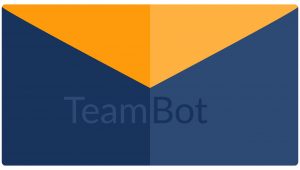
What is the only application that all professionals in the world use?
Exactly. It is the email. For years professionals around the world complained about how uncomfortable it can be if it is used as a documentation repository and even claimed that emails are "dead". Even so, it is very clear that mail is still unrivaled in the day to day of any office.
Of course, at ITM Platform we do not want to help your inboxes become messy garbage dumps.
No more unwanted notifications
The problem with email in B2B environments is not so much the channel, but the frequency. Usually, most applications send notifications automatically and, unless they are very well designed, their volume increases rapidly and end up being ignored.
With Teambot the opposite occurs: it is an ally of our users because it only sends a notification when it is requested.
The functioning is very simple:
- I write an email to Teambot
- I include my request for information on the message subject
- Teambot reads mu subject and my email address
- Teambot sends me an email with the requested information
This whole process can last less than 6 seconds. And you do not even need to log into ITM Platform. This is the reason why all our customers are adding Teambot to their list of regular contacts.
Semantic searches from the subject
The truly elegant thing about Teambot is that it offers precise and complex information from an absolutely minimalist user interface. We have decided to follow one of the best design maxims: less is more.
 Less is more." width="886" height="626" />
Less is more." width="886" height="626" />
In order to provide users with the highest advantages, we have transformed the email into a search engine... applied to all ITM Platform projects and tasks.
The search engine uses only the metadata fields. Specifically, two fields:
- The addressee, who is always teambot@itmplatform.io
- The subject, where the user indicated the information they are looking for.
Benefits of Teambot
- As a Team Member, you can organize your day without logging into ITM Platform
By simply sending an email to Teambot with the subject “today”, you will receive all the tasks to which you are assigned and all the projects in which you participate.
From there, you can request more details with a simple click.
- As a project manager, you can swiftly check the status of critical tasks
Do you have doubts about the status of a task? Ask Teambot and you will find out immediately.
- As a PMO administrator, you can quickly check the status of any project
With the access privileges of a Full Access license, PMO managers can use Teambot to gather the most important information about the status of a project. In order to do this, they just have to send an email to Teambot with the name of the project (or a part of it) in the mail subject. If there is more than one option, Teambot will send a clarification email.
- With Teambot you can work offline
From now on, users who are in geographical environments with connectivity problems can continue working while they are offline, obtaining the detailed information they need. With Teambot, the email server will send and receive emails even in locations with very low connectivity; and once the information is received, it will be available anywhere in offline mode.
- With Teambot you can respond to your boss with precision
Another useful feature is the simplicity of reporting information to anyone, just forward the information offered by Teambot.
How to give Teambot instructions for email
Teambot reads the email subject to find out what you need. The first command you can try with Teambot could be “help”; Teambot will send you instructions on the type of commands available and the answer you will get:
- Task lists for a given day: list tasks
- Complete lists of tasks: list all tasks
- Complete lists of projects: list all projects
- Task details: name of the task
- Project details: name of the project
Beyond the basic instructions, we wanted Teambot to be able to listen to our users and understand what they want to know. So, for example, if you send Teambot an email with the subject “corporate plan”, it will return a list of tasks and projects whose name resembles the subject.
In the next phases, we hope that Teambot will continue learning new rules of behavior and will become even more useful and helpful, offering proactive reminders when, for example, the delivery date of a critical task approaches; or allowing to report hours and progress by email.

 Why make status reports?
Why make status reports?